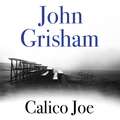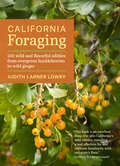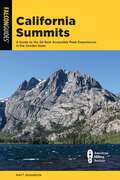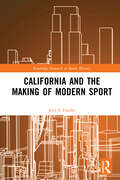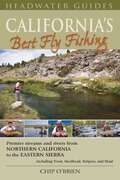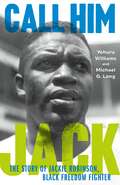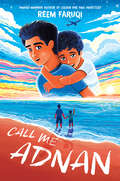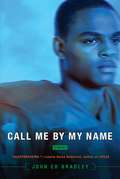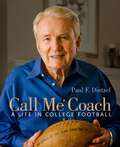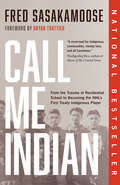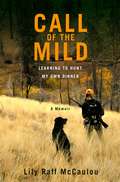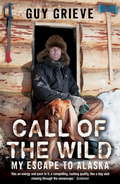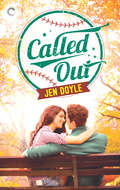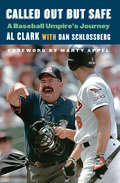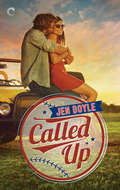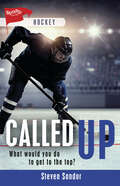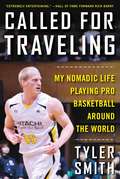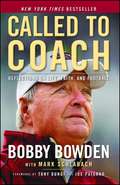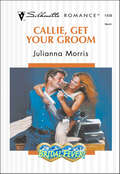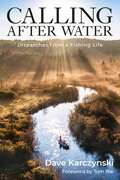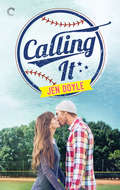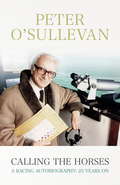- Table View
- List View
Calico Joe: An unforgettable novel about childhood, family, conflict and guilt, and forgiveness
by John GrishamAn unforgettable novel about childhood, family, conflict and guilt from America's greatest storyteller John Grisham.Thirty years have passed since eleven-year-old Paul Tracy watched his troubled father, Warren, a pitcher for the New York Mets, clash with his childhood hero, the Cubs' golden-boy Joe Castle, in a contest from which no winners emerged.Now the news that his father is dying brings the memory of that day flooding back. Deciding that it's time to face up to what really happened on that baseball field in 1973, father and son make their way to Calico Rock, Arkansas, where either redemption or rejection awaits them.(P)2012 Random House Audio
California Foraging: 120 Wild and Flavorful Edibles from Evergreen Huckleberries to Wild Ginger (Regional Foraging Series)
by Judith Lowry“This book is an excellent deep dive into California’s wild edibles, revealing a real affection for and intimate familiarity with our state’s flora.” —Iso Rabins, founder of ForageSF California offers a veritable feast for foragers, and with Judith Larner Lowry as your trusted guide you will learn how to safely find and identify an abundance of delicious wild plants. The plant profiles in California Foraging include clear, color photographs, identification tips, guidance on how to ethically harvest, and suggestions for eating and preserving. A handy seasonal planner details which plants are available during every season. Thorough, comprehensive, and safe, this is a must-have for foragers in the Golden State.
California Summits: A Guide to the 50 Best Accessible Peak Experiences in the Golden State
by Matt JohansonCalifornia Summits guides readers to 50 beautiful, attainable peak hikes. Hikers can summit most in a day, and sometimes in just a few hours, with a minimum of experience and gear. Everyone from families to experienced peak-baggers will find something to love. Hike up scenic Mount Tamalpais overlooking San Francisco Bay, Yosemite National Park&’s grand Clouds Rest with its incomparable view of Half Dome, and snowcapped Mount Shasta, the state&’s northern jewel, among others. Stunning color photography and detailed hike descriptions provide inspiration and information for hikers of all ages and experience levels.
California and the Making of Modern Sport (Routledge Research in Sports History)
by Joel S. FranksThis book examines the importance of California - a socio-cultural, economic and political powerhouse - in the history of modern sport. It argues that California has had a profound influence, for better or worse, on the way that not only America but also the wider world plays sport and spends money to watch others play.The book traces the history of sport in California from the mid-nineteenth century to the present, and looks at how the state’s historical development, its climate, and its unique racial and ethnic demographics have influenced sport at the elite level and in the wider community. It considers the importance of spatial politics and cultural citizenship in the development of Californian sport, and tells the story of how franchises such as the 49ers and the Lakers, as well as individual athletes such as Jackie Robinson and Billie Jean King have had a profound influence on the way their sports have been consumed, across America and in the wider world. The book also takes a close look at the impact of mega-sporting events in the Californian story, providing historical context for the LA 2028 Olympic Games and tracing the full arc of the ‘Californization’ of modern sports.This is fascinating reading for anybody with an interest in sport history, American history, social and cultural history, or the relationship between sport and wider society.
California's Best Fly Fishing
by Chip O'BrienWhether you want to crack the code of Northern California's legendary wild-trout waters, learn the best floats on the Sac, or fish for steelhead, stripers, and shad on the American River, this guide is the best place to start for a successful fishing trip. With stunning photos, detailed maps and hatch charts for each river, photos and recipes of the most effective fly patterns, and insider information from local guides and outfitters, California's Best Fly Fishing is an essential reference for the best fishing in the state.
California's Best Nature Walks: 32 Easy Ways to Explore the Golden State's Ecology
by Charles HoodExplore some of California&’s most exquisite landscapes with this accessible hiking guidebook featuring descriptions of the flora, fauna, and ecology hikers will discover along the trail. See the oldest trees in the world—and the tallest. Meet earthquake-loving fish, lively island foxes, and endemic birds. Visit the saltwater homes to sea otters and a desert basin where the water is even saltier. In California&’s Best Nature Walks, Charles Hood reveals the golden state&’s unique ecosystems, guiding you through 32 spectacular natural areas, with advice on deciphering the terrain. All are within easy walking distance of the road. This is an essential companion for road-trippers, outdoor enthusiasts, and day hikers—no cleated boots or trekking poles necessary. Locations include the Arcata Marsh and Wildlife Sanctuary, McConnell Arboretum and Botanical Gardens, Olmsted Point at Yosemite National Park, Fossil Falls, Camp Roberts Rest Area along Highway 101, Scorpion Anchorage at Channel Islands National Park, Vasquez Rocks Natural Area, and more!
Call Him Jack: The Story of Jackie Robinson, Black Freedom Fighter
by Michael G. Long Yohuru WilliamsAn enthralling, eye-opening portrayal of this barrier-breaking American hero as a lifelong, relentlessly proud fighter for Black justice and civil rights.According to Martin Luther King, Jr., Jackie Robinson was “a sit-inner before the sit-ins, a freedom rider before the Freedom Rides.” According to Hank Aaron, Robinson was a leader of the Black Power movement before there was a Black Power movement. According to his wife, Rachel Robinson, he was always Jack, not Jackie—the diminutive form of his name bestowed on him in college by white sports writers. And throughout his whole life, Jack Robinson was a fighter for justice, an advocate for equality, and an inspiration beyond just baseball.From prominent Robinson scholars Yohuru Williams and Michael G. Long comes Call Him Jack, an exciting biography that recovers the real person behind the legend, reanimating this famed figure’s legacy for new generations, widening our focus from the sportsman to the man as a whole, and deepening our appreciation for his achievements on the playing field in the process.
Call Me Adnan
by Reem Faruqi"An emotional tale of a family’s grief and healing, full of courage and hope" —Kirkus"Faruqi renders this tender story of loss with a deft hand, employing vivid details surrounding Adnan’s Pakistani Muslim identity . . . and nuanced characterizations to present a tear-jerking ode to family." —Publishers Weekly (starred review)"A realistic, moving exploration of family, loss, and healing." —Booklist"Faruqi takes on the difficult subject of family loss with beauty and grace in her gentle lyrical style. She allows Adnan, a young table-tennis enthusiast, to go through grief while holding not just sadness, but love and joy, in an honest and nuanced story that is ultimately filled with hope."—Veera Hiranandani, Newberry Honor author of The Night DiaryFor fans of Planet Omar and The Ethan I Was Before, award-winning Pakistani author Reem Faruqi of Unsettled delivers a middle grade novel in verse about table tennis player Adnan, who dreams of the championship and a fun-filled family trip to Florida. But when tragedy strikes, he and his family must cope with a terrible loss and come together as one again. This poignant story about a Muslim family learning to heal is hope-filled and moving.Adnan Zakir loves table tennis. He's also colorblind, left-handed, and has a fondness for the aviation alphabet. He's super close with his sister, Aaliyah, who is a great dancer and memorizer of Quran, and he loves his little toddler brother Rizwan, who only wants to grow up and play table tennis like his big brother. All Adnan dreams of is making it to the Ultimate Table Tennis Championship in Florida, and if he qualifies for the tournament, he knows he will get to spend the Eid holiday with his cousins! But when the family travels there, unthinkable tragedy strikes, and Adnan swears he'll never play table tennis ever again. Slowly, he and his family must learn to make peace and move forward, as a family.A Junior Library Guild Gold Standard Selection!
Call Me By My Name
by John Ed BradleyFrom former football star and bestselling author John Ed Bradley comes a searing look at love, life, and football in the face of racial adversity. "Heartbreaking," says Laurie Halse Anderson, author of Speak.Growing up in Louisiana in the late 1960s, Tater Henry has experienced a lot of prejudice. His town is slow to desegregate and slower still to leave behind deep-seated prejudice. Despite the town's sensibilities, Rodney Boulett and his twin sister Angie befriend Tater, and as their friendship grows stronger, Tater and Rodney become an unstoppable force on the football field. That is, until Rodney sees Tater and Angie growing closer, too, and Rodney's world is turned upside down. Teammates, best friends--Rodney's world is threatened by a hate he did not know was inside of him. As the town learns to accept notions like a black quarterback, some changes may be too difficult to accept.
Call Me Coach: A Life in College Football
by Paul F. DietzelWhen LSU head football coach Paul Dietzel saw Billy Cannon field an Ole Miss punt on LSU's own eleven yard line on a stifling Halloween night in 1959, his shouts of "No, no, no!" turned to "Go, go, go!" as Cannon eluded tackler after tackler, sending fans in Tiger Stadium into a frenzy and earning himself that year's Heisman Trophy. Dietzel is probably best known for leading LSU to its first national championship the year before Cannon's legendary run, but his career in athletics also carried him to numerous posts across the country and put him in the company of some of the best coaching minds of all time. In Call Me Coach, Dietzel affectionately recalls his rich and varied life in college football.In 1948, Dietzel decided to forgo medical school at Columbia University to become the plebe football coach at West Point. As an assistant over the next few years, he worked with Bear Bryant at the University of Kentucky, Colonel Red Blaik and Vince Lombardi at West Point, and Sid Gillman at the University of Cincinnati. Taking the job of head coach at LSU in 1955, he reversed the Tigers' losing skid and -- using the wing-T formation and a revolutionary three-team substitution system incorporating the White Team, the Go Team, and the renowned Chinese Bandits -- crafted 1958's unbeaten championship season. The thirty-three-year-old Dietzel was voted National Coach of the Year by the widest margin ever. Back at West Point from 1961 to 1965, Dietzel rallied the Cadets to finally "beat Navy" and, as South Carolina's football coach and athletics director from 1966 to 1974, he took the Gamecocks to their first bowl game in twenty-five years and mandated the recruitment of black athletes in all sports programs. After twenty years as a head coach, with 109 wins and 95 losses at three schools and a postseason record of 11 victories and 3 defeats, Dietzel retired from coaching in 1974, later serving as athletics director at Indiana and LSU.Through Dietzel's eyes, readers glimpse college football during a simpler time but also see that many facets of the game -- including recruitment challenges, job insecurity, press relations, and fickle fans -- remain constant. Highlights among the book's many unforgettable anecdotes are a 1962 interview with Howard Cosell, discussion about West Point's football team with General Douglas MacArthur, and a rare disagreement with Bear Bryant during a staff meeting. Dietzel's recollections of his early and later years help complete the story of the man. In a warm raconteur's voice, he describes his impoverished childhood in Ohio, his own participation in high school and college sports, and his stint flying B-29 missions over Japan during World War II. His postretirement endeavors have included providing color commentary for TV, selling fudge, teaching skiing, and watercolor painting. Always at the top of Dietzel's priorities have been friends, family, and faith.Gratitude rings as a constant refrain in Call Me Coach, and sports enthusiasts everywhere will be grateful that Dietzel has shared these recollections of his remarkable life.
Call Me Indian: From the Trauma of Residential School to Becoming the NHL's First Treaty Indigenous Player
by Fred Sasakamoose"Fred Sasakamoose played in the NHL before First Nations people had the right to vote in Canada. This page turner will have you cheering for 'Fast Freddy' as he faces off against huge challenges both on and off the ice--a great gift to every proud hockey fan, Canadian, and Indigenous person."--Wab Kinew, Leader of the Manitoba NDP and author of The Reason You WalkTrailblazer. Residential school Survivor. First Treaty Indigenous player in the NHL. All of these descriptions are true--but none of them tell the whole story.Fred Sasakamoose, torn from his home at the age of seven, endured the horrors of residential school for a decade before becoming one of 120 players in the most elite hockey league in the world. He has been heralded as the first Indigenous player with Treaty status in the NHL, making his official debut as a 1954 Chicago Black Hawks player on Hockey Night in Canada and teaching Foster Hewitt how to pronounce his name. Sasakamoose played against such legends as Gordie Howe, Jean Beliveau, and Maurice Richard. After twelve games, he returned home.When people tell Sasakamoose's story, this is usually where they end it. They say he left the NHL to return to the family and culture that the Canadian government had ripped away from him. That returning to his family and home was more important to him than an NHL career. But there was much more to his decision than that. Understanding Sasakamoose's choice means acknowledging the dislocation and treatment of generations of Indigenous peoples. It means considering how a man who spent his childhood as a ward of the government would hear those supposedly golden words: "You are Black Hawks property."Sasakamoose's story was far from over once his NHL days concluded. He continued to play for another decade in leagues around Western Canada. He became a band councillor, served as Chief, and established athletic programs for kids. He paved a way for youth to find solace and meaning in sports for generations to come. Yet, threaded through these impressive accomplishments were periods of heartbreak and unimaginable tragedy--as well moments of passion and great joy.This isn't just a hockey story; Sasakamoose's groundbreaking memoir sheds piercing light on Canadian history and Indigenous politics, and follows this extraordinary man's journey to reclaim pride in an identity and a heritage that had previously been used against him.
Call Me Roberto!: Roberto Clemente Goes to Bat for Latinos
by Nathalie AlonsoHere is the inspirational story of Major League Baseball player Roberto Clemente—not Bob—who endured years of racism and discrimination to become one of the greatest baseball players of all time.Roberto Clemente always loved baseball. Growing up in Carolina, Puerto Rico, he swung tree branches (since he didn&’t have a bat) and hit tin cans. He was always batting, pitching, running, sliding. His dedication paid off when, at the age of 19, he was tapped for a major league team. First stop: chilly Montreal . . . where he warmed the bench and himself, longing to play baseball. Months later, he finally got his chance with the Pittsburgh Pirates. Clemente had an instant impact on the field—hitting the ball and making it to first base and finally home. Many Pittsburgh fans loved his bold style on the field, but not everyone was quick to embrace a Black man from Puerto Rico who spoke español.This nonfiction picture book by MLB.com journalist Nathalie Alonso and award-winning illustrator Rudy Gutierrez shows the emotional highs and lows of Roberto Clemente&’s career as he fought racism—from fans, reporters, and other figures in the sport—to become one of the greatest baseball players of all time. With English and Spanish words intermingled in the text, this book will inspire young readers as they learn about Clemente&’s contributions to Black, Latino, and American history.
Call of the Mild: Learning to Hunt My Own Dinner
by Lily Raff MccaulouWhen Lily Raff McCaulou traded in an indie film production career in New York for a reporting job in central Oregon, she never imagined that she'd find herself picking up a gun and learning to hunt. She'd been raised as a gun-fearing environmentalist and an animal lover, and though a meat-eater, she'd always abided by the principle that harming animals is wrong. But Raff McCaulou's perspective shifted when she began spending weekends fly-fishing and weekdays interviewing hunters for her articles, realizing that many of them were more thoughtful about animals and the environment than she was. So she embarked upon the project of learning to hunt from square one. From attending a Hunter Safety course designed for children to field dressing an elk and serving it for dinner, she explores the sport of hunting and all it entails, and tackles the big questions surrounding one of the most misunderstood American practices and pastimes. Not just a personal memoir, this book also explores the role of the hunter in the twenty-first century, the tension (at times artificial) between hunters and environmentalists, and new models of sustainable and ethical food procurement.
Call of the Wild: My Escape to Alaska
by Guy GrieveGuy Grieve's life was going nowhere - trapped in a job he hated, commuting 2,000 miles a month and up to his neck in debt. But he dreamed of escaping it all to live alone in one of the wildest, most remote places on earth - Alaska. And just when he'd given up hope, the dream came true. Suddenly Guy was thrown into one of the harshest environments in the world, miles from the nearest human being and armed with only the most basic equipment. And he soon found - whether building a log cabin from scratch, hunting, ice fishing or of course dodging bears in the buff - that life in the wilderness was anything but easy...Part Ray Mears, part Bill Bryson, CALL OF THE WILD is the gripping story of how a mild-mannered commuter struggled with the elements - and himself - and eventually learned the ways of the wild.
Called Out
by Jen DoyleJen Doyle is back with another hot and heartfelt home run of a contemporary romance. Fans of Jill Shalvis should prepare to swoon over Jack and Lola's HEA. Jack "Ox" Oxford is used to being alone. Granted, when you screw over your friends, being alone isn't always a choice. Playing for the Chicago Watchmen is a last-ditch effort to save his career...and right some of his past wrongs. He's not expecting a warm reception, but he's also not expecting a flat tire to change everything. Recovering control freak, single mom and semiprofessional chaos wrangler Lola Deacon McIntire doesn't need an arrogant ballplayer to swoop in and save her from anything, much less her flat tire. And she definitely doesn't need her body to betray her and decide this is the guy to wake up her rusty libido. She isn't about to upset her sons' lives for any man-much less one who so clearly doesn't think he's dad material. Jack never thought he'd find someone who wanted to build a life with him, but the more time he spends with Lola and her boys, the more it starts to feel permanent. Even tough-as-nails Lola concedes there just might be a future here-the big, beautiful, messy future neither of them was looking for-but only if Jack will accept he deserves it. This book is approximately 100,000 words One-click with confidence. This title is part of the Carina Press Romance Promise: all the romance you're looking for with an HEA/HFN. It's a promise!
Called Out but Safe: A Baseball Umpire's Journey
by Dan Schlossberg Marty Appel Al ClarkIf an umpire could steal the show in a Major League game, Al Clark might well have been the one to do it. Tough but fair, in his thirty years as a professional umpire he took on some of baseball’s great umpire baiters, such as Earl Weaver, Billy Martin, and Dick Williams, while ejecting any number of the game’s elite—once tearing a hamstring in the process. He was the first Jewish umpire in American League history, and probably the first to eject his own father from the officials’ dressing room. But whatever Clark was doing—officiating at Nolan Ryan’s three hundredth win, Cal Ripken’s record breaker, or the “earthquake” World Series of 1989, or braving a labor dispute, an anti-Semitic tirade by a Cy Young Award winner, or a legal imbroglio—it makes for a good story. Called Out but Safe is Clark’s outspoken and often hilarious account of his life in baseball from umpire school through the highlights to the inglorious end of his stellar career. Not just a source of baseball history and lore, Clark’s book also affords a rare look at what life is like for someone who works for the Major Leagues’ other team.
Called Up
by Jen DoyleJen Doyle delivers a home run of heart, heat and plenty of laughter in this contemporary romance, perfect for fans of Jill Shalvis's Pacific Heat seriesThere's one thing Max "Deke" Deacon can always count on besides his old high school teammates: Angelica "Fitz" Hawkins. But no matter how much Deke might secretly fantasize otherwise, a relationship with his best friend's sister is off limits. Until one unexpectedly smoldering encounter has Deke and Fitz giving in to the feelings they've both been fighting for far too long.Fitz knows for a fact that it is not better to have loved and lost. After losing her parents, she'd rather lock up her heart and throw away the key than endure that kind of pain again. If that means giving up any hope of a lasting relationship, then so be it.But with Deke, Fitz feels dangerously close to falling in love. She can't risk another broken heart--especially if it means losing one of her best friends for good. Now it's up to Deke to convince her that the safest place she could ever be is right here with him.This book is approximately 100,000 wordsOne-click with confidence. This title is part of the Carina Press Romance Promise: all the romance you're looking for with an HEA/HFN. It's a promise! Find out more at CarinaPress.com/RomancePromise
Called Up (Lorimer Sports Stories)
by Steven SandorFor thirteen-year-old David Timko, making the Bantam A hockey team is everything. So when he doesn't make the cut, his bad attitude soon gets him benched. Even worse, his new friend at school, Omar, shows a complete lack of understanding of David's problem. Omar has problems of his own. A recent Syrian refugee, he's angry that his parents can't find good jobs in his new country, among other problems. As both boys become more frustrated with their own problems, their friendship begins to suffer. Can the two boys come to an understanding of each other's problems before their friendship comes to blows? Distributed in the U.S by Lerner Publishing Group.
Called for Traveling: My Nomadic Life Playing Pro Basketball around the World
by Tyler SmithCalled for Traveling is a pro basketball journey that spans four continents, seven countries and twelve teams over eleven hilarious and adventurous years. After playing his college ball at Penn State, Tyler Smith had a path in mind of where he wanted his pro basketball career to lead. Bringing his own toilet paper to away games, courts made of concrete, and fully-geared riot police at every stadium were not part of his original dream. Where were all the big contracts people talked about? Would he even have a job next season—or next week? And would he be playing for free this month because the team didn’t feel like paying him?In this highly unstable and unorthodox overseas lifestyle as a professional basketball player, Smith draws readers in quickly with his humor and ability to share his clever stories that seem outrageous, but are 100 percent true. His attitude and faith are tested relentlessly through bounced paychecks, injuries, and the seemingly endless frustrating reality of people around him speaking a language he could not understand.From Italy to Japan to Uruguay, and even the NBA, the challenges and adventures only accelerate as Tyler’s wife and kids are added to the overseas equation. His unique story is highly engaging whether or not you’re a basketball junkie. Called for Traveling is an honest and entertaining inside look at one man’s journey playing pro basketball around the world.
Called to Coach: Reflections on Life, Faith, and Football
by Bobby Bowden Mark SchlabachCoach Bobby Bowden is an icon of college football who ran his legendary, top-ranking program with a trademark southern charm. With his recent retirement, Bowden is ready to give fans and readers the behind-the-scenes story of his 55-year career and the path that helped him become one of college football's most successful coaches and patriarch of the sport's most famous coaching family. In this book, Bowden will reveal never-before-published details of the moments and events that have defined his life, including: * The tragic death of his grandson and son-in-law in a 2004 automobile accident.* The details of his retirement as FSU's coach at the end of the 2009 season.
Callie Cat, Ice Skater
by Eileen Spinelli Anne KennedyDay and night, Callie Cat ice skates on the pond in her backyard. She loves to ice skate, loves it more than chocolate cake, more than going to the mall--more than her friends can understand. That is, until the Honeybrook Ice Rink announces a contest, and everyone thinks it could be Callie's big chance! Now Callie practices day and night. She wants to win the big prize . . . doesn't she?
Callie, Get Your Groom (Bridal Fever!)
by Julianna MorrisNO MORE NICE GIRL.Spirited Callie Webster was done staying home on Saturday nights-alone. Now was the time to be a little bad. Just enough to win the heart of the man she'd dreamed of since childhood. But first he had to notice her. Michael Fitzpatrick couldn't believe the changes in innocent Callie. Suddenly she was dating every available man in Alaska-and forcing him to act like a protective big brother. But "brotherly" wasn't what he was feeling! Heck, despite his marriage-resistant tendencies, Michael was imaging how much fun staying home every night with Callie could be!
Calling After Water: Dispatches from a Fishing Life
by Dave KarczynskiDave Karczynski fishes—and writes—with both eyes wide open to the magic of water. With the trademark blend of adventure, humor, and insight that has made him one fly fishing&’s most widely published authors, this collection of nineteen essays charts Dave&’s journey as he casts his way from the quiet streams of the Upper Midwest to the far corners of the earth—and back again. Readers will tramp across Patagonia with a shamanic brook trout whisperer, raft through the Himalayas in search of golden mahseer, hunt native brown trout in the Bohemian highlands, and revel in the promise of a Northern Michigan spinner fall. With prose that alternately flashes like the sides of a leaping salmon and glitters like riffle water on a summer morning, Calling After Water is one of those rare books that delights its readers as much as it invites them to reflect on their own love of fly fishing.
Calling It
by Jen DoyleBaseball player Nathan Hawkins needs to get away from Chicago. After a near career-ending car accident and with paparazzi surrounding his penthouse, Nate can only think of one place to go: home. But when he finds his old apartment occupied by a half-naked woman wielding a baseball bat, he's not sure what to think...except that maybe his luck has finally changed for the better.Librarian Dorie Donelli never thought she'd get to meet her fantasy man in person--much less in her bathrobe. To her surprise, her nearly naked run-in with Nate leads to more unclothed encounters. But Dorie is sure their fling is only temporary. As long as she remembers he'll be gone once his life gets back on track, she won't get hurt. In the meantime, she throws herself into enjoying their three weeks together before he has to report for spring training and go back to his old life.For Nate, being with Dorie is the only time in months that he finds himself smiling. Laughing. And he has no intention of letting that go. He might even be falling in love...if only Dorie will let him say the words. What they have isn't just a dream, but the start of a dream come true.This book is approximately 101,000 words
Calling The Horses: A Racing Autobiography
by Peter O'SullevanFor decades Peter O'Sullevan was one of the iconic sports commentators, providing the sound track for half a century of horseracing as he called home such legends of the sport as Arkle, Nijinsky, Red Rum and Desert Orchid. His rapid-fire commentary seemed to echo the sound of horses' hooves, and it was not long before he became known as 'The Voice of Racing'. But in addition to his legendary status as a TV personality, Peter O'Sullevan was also a notable journalist and much-admired writer, and it is a measure of his standing both within and beyond the world of racing that his compulsively readable autobiography Calling the Horses, first published in 1989 and reprinted eight times, reached the top of the SUNDAY TIMES non-fiction bestseller list. The most recent edition of Calling the Horses was published in 1994, and the twenty years since then have brought many fresh episodes in the ongoing Peter O'Sullevan story, including the last racing days of his great friend Lester Piggott in 1995, his commentary on the 'Bomb Scare' Grand National of 1997, and his retirement from the BBC. He also describes setting up the Sir Peter O'Sullevan Charitable Trust, which has raised over £3.5 million for animal welfare charities, as well as offering his appreciation of a new generation of racing heroes, including jockey AP McCoy, who has come to dominate jump racing in a manner unparalleled in any sport, and the wonder-horse Frankel. The heartening news for the legions of Peter O'Sullevan fans is that, despite his years, his enthusiasm for racing is undiminished, and so are the elegance, fluency and wit which infuse his writing style. This new and extensively updated edition of Calling the Horses is a very remarkable book by a very remarkable man.
